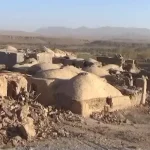On Sunday, a Taliban government spokeswoman said that the dead toll from the massive earthquakes that struck western Afghanistan had risen to above 2,000. There hasn’t been a devastating earthquake in the country in over two decades.
According to the country’s national disaster administration, a magnitude 6.3 earthquake and accompanying severe aftershocks killed dozens of people in western Afghanistan on Saturday.
The death toll from the earthquake in Herat was first thought to be lower, but Abdul Wahid Rayan, a spokeswoman for the Ministry of Information and Culture, indicated that the figure is higher. He said that six villages had been destroyed and that hundreds of inhabitants were missing or thought dead.
The first earthquake struck 40 kilometers west of Herat at around 11 a.m. local time, according to the United Nations Office for the Coordination of Humanitarian Affairs in Afghanistan. The shocks were felt in the neighboring provinces of Badghis and Farah as well.
“Initial assessments indicate that as many as 100 people have been killed across eight villages in Zindajan Province, Herat Province … with a further 500 people injured,” according to a report issued by the agency. The report also noted that “unconfirmed reports suggest this figure may be closer to 320 people.”
Four villages in the Zenda Jan area of Herat province were particularly heavily damaged by the earthquake and its aftershocks, according to Mohammad Abdullah Jan, a spokesperson for the disaster agency.
The World Health Organization’s Afghan division reported sending 12 ambulances to Zenda Jan to transfer patients.
“As deaths and casualties from the earthquake continue to be reported,” the United Nations agency tweeted on X (previously known as Twitter). “Teams are in hospitals assisting treatment of wounded & assessing additional needs.” “WHO-supported ambulances are transporting those affected, most of them women and children.”
The lack of functioning cellphones in Herat made gathering information from the city’s devastated areas difficult, but social media photographs showed hundreds of people gathered in the streets outside their homes and offices.
According to the group, 465 homes were demolished and 135 were damaged, impacting a total of 4,200 people (about 600 families). According to the report, Mahal Wadakha was the hardest damaged village.
“Partners and local authorities expect the number of casualties to rise as search and rescue efforts continue amid reports that some people may be trapped beneath collapsed buildings,” said the United Nations Office for the Coordination of Humanitarian Affairs in Afghanistan.
MORE: How to Assist Moroccan Earthquake Victims
According to preliminary information from the Afghanistan National Disaster Management Authority, at least 15 persons were killed and 40 were wounded.
As part of its response, the UN agency shared images of medical personnel treating patients in the open air.
Meanwhile, the Taliban’s economic advisor, Abdul Ghani Baradar, expressed his sympathies to the martyrs’ families in Herat and Badghis.
The Taliban urged local groups to hurry supplies to earthquake zones so that casualties could be transported to hospitals, the homeless could be housed, and the hungry could be fed. Authorities were advised to use all available resources to locate people trapped alive in the wreckage.
“We ask our wealthy compatriots to give any possible cooperation and help to our afflicted brothers,” the Taliban said on X.
UNICEF Afghanistan has also stated that it is in the country with its UN partners “to assess the full impact.”
On social media, UNICEF Afghanistan stated, “Once again, children and families in Afghanistan have been affected by a devastating earthquake, this time in western Herat province.”
In June 2022, a severe earthquake demolished stone and mud-brick houses in the harsh, steep terrain of eastern Afghanistan. The earthquake killed at least a thousand people and injured 1,500 more.















